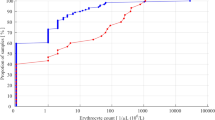Abstract
Lumbar puncture is a relatively safe procedure, but some serious, even fatal, complications can occur. Needle guidance can increase puncture accuracy, decrease the number of attempts, and make the procedure easier. We tested the feasibility of a bioimpedance-based tissue-sensing technology for needle guidance in clinical use. The Bioimpedance Probe (BIP) Needle has a removable BIP stylet enabling measurement of bioimpedance spectra during the procedure. The BIP Needle is connected to a measurement device that uses tissue-classification software, and the device provides audiovisual feedback when it detects cerebrospinal fluid (CSF). We performed spinal anesthesia with the BIP Needle in 45 patients. The device performance and needle tip location were verified by an experienced anesthesiologist confirming CSF leakage. The device detected CSF in all cases (sensitivity of 100 %). Six cases with false detections lowered the specificity to 81 %, but in practice, most of these were easy to differentiate from true detections because their duration was short and they occurred during backward movement of the needle. The epidural spectrum differentiated as fatty tissue from surrounding tissues, but the ligamentum flavum was not clearly detectable in the data. The BIP Needle is a reliable tool for detecting CSF in lumbar puncture. It can make the puncture procedure smoother, as repeated CSF flow tests are avoided. The correct needle tip location is immediately detected, thus unnecessary needle movements close to spinal nerves are prevented. Physicians could benefit from the information provided by the BIP Needle, especially in patients with obesity or anatomic alterations.



Similar content being viewed by others
References
Hermanides J, Hollmann MW, Stevens MF, Lirk P. Failed epidural: causes and management. Br J Anaesth. 2012;109(2):144–54.
Hyderally H. Complications of spinal anesthesia. Mt Sinai J Med. 2001;69(1–2):55–6.
Kang XH, Bao FP, Xiong XX, Li M, Jin TT, Shao J, Zhu SM. Major complications of epidural anesthesia: a prospective study of 5083 cases at a single hospital. Acta Anaesth Scand. 2014;58(7):858–66.
Pitkänen MT, Aromaa U, Cozanitis DA, Förster JG. Serious complications associated with spinal and epidural anaesthesia in Finland from 2000 to 2009. Acta Anaesth Scand. 2013;57(5):553–64.
Chin KJ, Perlas A, Chan V, Brown-Shreves D, Koshkin A, Vaishnav V. Ultrasound imaging facilitates spinal anesthesia in adults with difficult surface anatomic landmarks. Anesthesiology. 2011;115(1):94–101.
Seeberger MD, Kaufmann M, Staender S, Schneider M, Scheidegger D. Repeated dural punctures increase the incidence of postdural puncture headache. Anesth Analg. 1996;82(2):302–5.
Kopacz DJ, Neal JM, Pollock JE. The regional anesthesia “learning curve”. What is the minimum number of epidural and spinal blocks to reach consistency? Reg Anesth. 1995;21(3):182–90.
Kalvøy H, Frich L, Grimnes S, Martinsen ØG, Hol PK, Stubhaug A. Impedance-based tissue discrimination for needle guidance. Physiol Meas. 2009;30(2):129–40.
Trebbels D, Fellhauer F, Jugl M, Haimerl G, Min M, Zengerle R. Online tissue discrimination for transcutaneous needle guidance applications using broadband impedance spectroscopy. IEEE Trans Biomed Eng. 2012;59(2):494–503.
Kalvøy H, Sauter AR. Detection of intraneural needle-placement with multiple frequency bioimpedance monitoring: a novel method. J Clin Monitor Comput. 2015;. doi:10.1007/s10877-015-9698-3.
Mishra V, Schned AR, Hartov A, Heaney JA, Seigne J, Halter RJ. Electrical property sensing biopsy needle for prostate cancer detection. Prostate. 2013;73(15):1603–13.
Hernandez DJ, Sinkov VA, Roberts WW, Allaf ME, Patriciu A, Jarrett TW, et al. Measurement of bio-impedance with a smart needle to confirm percutaneous kidney access. J Urol. 2001;166(4):1520–3.
Kari J, Annala K, Annus P, Seppä V-P, Kronström K (2015) A thin needle with bio-impedance measuring probe: tissue recognition performance assessed in in vivo animal study. http://injeq.com/hallinta/data/files/BRC. Accessed 12 May 2015.
Grimness S, Martinsen ØG. Bioimpedance and bioelectricity basics. 2nd ed. London: Academic Press; 2008.
Ragheb T, Geddes LA. The polarization impedance of common electrode metals operated at low current density. Ann Biomed Eng. 1991;19(2):151–63.
Schwan HP. Linear and nonlinear electrode polarization and biological materials. Ann Biomed Eng. 1992;20(3):269–88.
Gabriel S, Lau RW, Gabriel C. The dielectric properties of biological tissues: II. Measurements in the frequency range 10 Hz to 20 GHz. Phys Med Biol. 1996;41(11):2251–69.
Mirtaheri P, Grimnes S, Martinsen ØG. Electrode polarization impedance in weak NaCl aqueous solutions. IEEE Trans Biomed Eng. 2005;52(12):2093–9.
Duda RO, Hart PE, Stork DG. Pattern classification. 2nd ed. New York: John Wiley & Sons; 2012.
De Andrés J, Reina MA, Prats A. Epidural space and regional anesthesia. Eur J Pain Suppl. 2009;3(2):55–63.
Baumann SB, Wozny DR, Kelly SK, Meno FM. The electrical conductivity of human cerebrospinal fluid at body temperature. IEEE Trans Biomed Eng. 1997;44(3):220–3.
Gabriel C, Gabriel S, Corthout E. The dielectric properties of biological tissues: I. Literature survey. Phys Med Biol. 1996;41(11):2231–349.
Acknowledgments
We thank M Rorarius, Assoc Prof em, who was involved in designing the present clinical study. We also thank all participating patients and study nurses. Injeq Ltd provided BIP Needles and bioimpedance analyzer for the study.
Funding
This research was supported by the European Union through the European Regional Development Fund in frames of the research center CEBE and competence center ELIKO, and also by Estonian Research Council (IUT-19-11-2014).
Author information
Authors and Affiliations
Corresponding author
Ethics declarations
Conflict of interest
S. H., J. K., and K. K. are employees of Injeq Ltd, K. K. is a stakeholder of Injeq Ltd.
Ethical approval
All procedures performed in studies involving human participants were in accordance with the ethical standards of the institutional research committee and with the 1964 Helsinki declaration and its later amendments or comparable ethical standards.
Additional information
Sanna Halonen and Kari Annala have contributed equally.
Rights and permissions
About this article
Cite this article
Halonen, S., Annala, K., Kari, J. et al. Detection of spine structures with Bioimpedance Probe (BIP) Needle in clinical lumbar punctures. J Clin Monit Comput 31, 1065–1072 (2017). https://doi.org/10.1007/s10877-016-9915-8
Received:
Accepted:
Published:
Issue Date:
DOI: https://doi.org/10.1007/s10877-016-9915-8




